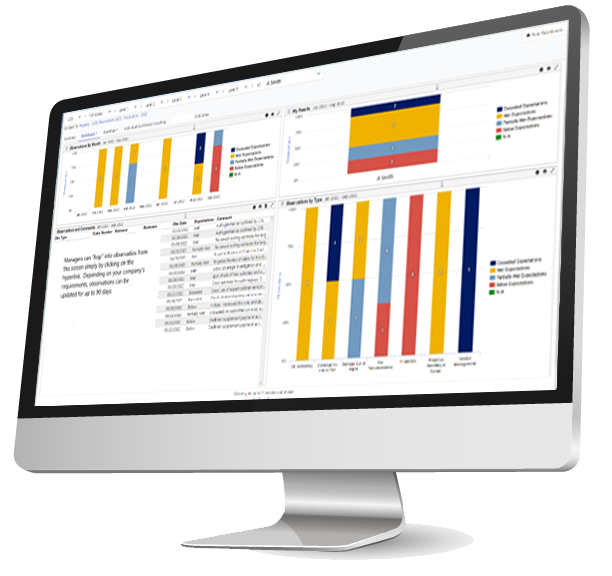Is the Quality Assurance program at your company perceived as negative? If so, you are not alone. This is a common theme among many such programs at top insurance carriers. Front-line contributors imagine that their every action is being monitored, and audit feedback is considered negative instead of constructive. As a result, managers performing audits dread the process every month and thus oftentimes delay completion of quality reviews. For this reason, Quality Assurance program managers have repeatedly asked Athenium: How can we change this negative perception of our Quality Assurance program to a more positive one, allowing quality to become a constructive part of everyday culture within an insurance carrier’s operations?
To begin to answer this complex question, what if there was a solution – fast and efficient to implement – that could improve the way your company’s quality data is used, incorporate quality into your culture more positively, and improve documentation and performance simultaneously? If such a tool would provide benefits to your organization, then teamthink’s Observations module might fit the bill.
Users of teamthink have access to the premier quality assurance solution in the marketplace for insurance carrier quality teams to manage audit reviews with greater speed, volume and accuracy. teamthink’s comprehensive measurement, analysis and reporting tools deliver actionable information that enables quality assurance business managers with actionable information to drive company-wide performance. In addition to the core functionality teamthink provides to all users, insurance carries leveraging teamthink can also opt in to various expansion modules to enhance and configure teamthink to certain targeted needs. One such expansion module, the Observation module, is designed to meet the needs at all levels of your organization by providing continuous and valuable insights for improved, data driven decisions in processes, training, coaching, and the improvement process cycle.
What are Observations?
Observations are meant to capture a targeted and concise account of a specific process or behavior. Observations can be configured to any group or individual and are use case agnostic, meaning, they can be configured to both claims and underwriting organizations.
Managers can quickly document positive and negative behaviors during the process of observation reviews allowing for easy identification of individual or team behaviors and efficiency, scalable tracking of coaching opportunities across teams, business groups, or even the entire organization. While the module may sound like a performance management system, it is not. Rather, Observations is intended to support your existing performance management system and even your employee review system by making the documentation of feedback, coaching, training, and other opportunities more consistent, accessible, and pain-free.
Continuous Improvement
Many insurance companies have attempted to implement various continuous improvement programs throughout their organizations. However, a common complaint about these programs is the lack of ability to effectively track and measure those improvements. Since the quality data itself is one of the best places to identify improvement opportunities, having a continuous improvement tracking mechanism within your quality system that leverages such data would be logically beneficial. Observations empower organizations with this capability. Through the Observations module, users may identify areas for improvement and provide a consistent way to monitor improvement progress in a more efficient manner. Gaining quicker insights into process improvements will increase the impact to the organization or can highlight challenges in the improvement process.
If your company uses lean/agile methodologies, Observations can help document process walks, one-on-ones, and other daily activities critical to success in a particular role. Observations empower managers to provide real-time feedback and document outcomes consistently across the organization. Flexible to configuration, it can allow a group to focus on specific initiatives often driven by the continuous improvement process, track who is coaching effectively, and who is focused on applying feedback. Observations can provide strategy and initiative insight for effectiveness without adding unnecessary work or documentation for the manager, making the entire feedback loop much more manageable for the organization.
Quality Programs (Auditing)

Quality programs within an organization are usually the first place a company looks to launch new initiatives. Quality specialists are trained to understand the big picture and how impactful quality improvements can affect the broader organization. They are proficient at executing end-to-end focused reviews and providing meaningful insights at the highest levels.
From a data perspective, quality data is additional information that insurance carriers collect internally, but how often are those carriers accomplishing any objectives or extracting insights with this data? Due to the abundance of data these companies have, it can often be overwhelming and hard to prioritize how to leverage it. However, the business results can be compelling if a quality program is able to use data from Observations with audit data. An excellent quality program will identify hundreds of opportunities in an organization. In contrast, a best-in-class quality program will be able to analyze those opportunities and understand which will be most impactful to the organization. The auditors might recommend 3-5 key opportunities to focus on, and leadership will want to be able to measure the results. Using Observations, data can be quickly captured on those key opportunities related to initiative performance and effective adoption within the organization. By combining data from Observations with other quality data, an organization can track progress on key opportunities and be more effective at implementing and measuring critical organizational initiatives.
Front-Line Manager Feedback
Every company has struggled to provide constructive feedback to recipients, measure training effectiveness, and track performance. When quality becomes a day-to-day way of doing things in your organization, Observations can provide valuable insights into overall employee performance, making one-on-ones and employee reviews easier to manage – and more impactful.
In truth, front-line managers have one of the most challenging jobs within an insurance carrier’s operations and require substantial time to get their tasks completed. Quality audits are typically focused on specific processes and outcomes of the role of managers. A manager does not realistically have enough time in any given month or year to review a volume of performance files which would provide sufficient, statistically meaningful feedback at the employee level. However, some organizations have front-line managers performing quality audits of some sort. While such audits may be necessary, they may not always be the best use of the manager’s time, as a primary responsibility of that manager is to provide effective and timely coaching and feedback to the employees, and the act of conducting audits cuts into that coaching time. Instead, using Observations, central audit team reviews can be used as a guide that assists managers to recommend further coaching or identify unique situations, allowing those front-line managers to more efficiently make 10-20 quality Observations on an employee during any given month. This information, combined with central quality data and data from day-to-day tasks, allows managers to focus on coaching specific skills to improve the employee and team.
Observations provides a consistent way to document coaching, day-to-day tasks, and even customer feedback. Without consistency, front-line managers are often left to fend for themselves and provide feedback in various ways and formats. Some may even create folders on desktops, in outlook, on paper documentation, even simply rely on memory. This makes the performance review process grueling and tedious for everyone involved. Imagine if an employee changes managers during the year; the employee transition can be painful, especially if the manager relied purely on memory.
Observations can be an effective answer for all types of managers. The Observations module allows managers to document a coaching moment in minutes with just a few simple clicks. Immediate updates to the Observation dashboard provide managers instant insight into who needs more coaching touches and whether crucial initiatives have been discussed with each employee that month. Without the type of data a feature likes Observations can produce, it can be difficult for managers to know which tasks are incomplete or need to be addressed, often leaving them scrambling to assemble content for one-on-ones, huddles, or performance reviews. As employees transfer from manager to manager, the Observations on that employee move with the employee, creating data-driven consistency and more seamless transitions.
Training/Performance
When implementing a new training curriculum or getting a new hire up to speed, it is sometimes difficult to measure the effectiveness of the training. With Observations, managers can track training initiatives until the trainee achieves proficiency. It may also lead the training owner to realize an initiative may not work, uncovering a need to revisit the training plan. With effective measurement of training initiatives, it is possible to understand the actual impacts of the training, whether positive or negative.
While Observations are certainly not meant to take the place of HR systems, the simpleness of the teamthink Observations module can efficiently work with an organization’s HR platform. Consistent documentation is critical to the performance management process. Since Observations align with each role’s success measures, it is straightforward to identify when an employee is underperforming or struggling. As a manager focuses coaching and feedback on areas where improvement is required, Observations will allow the manager to monitor whether the employee is applying such feedback and improving over time. If a certain topic turns into a performance management situation, the manager may obtain specific, time-stamped feedback to support any decision, which all HR departments will appreciate.
The efficiency of the Observations module will not only save time for front-line managers, trainers, and the central quality assurance team, it will also yield considerable return on increasing the effectiveness at which improvements can be developed. Observations strengthen the improvement process with intelligent data trending analysis and visualizations, resulting in faster adoption of process enhancements and team or employee improvements. By integrating Observations into your organization’s quality program, the value provided can become an inherent part of the company culture. Once a part of the culture, the actionable insights provided by the Observations module can take the sting out of a Quality Assurance Program.
Advancements to Observations
Some managers are great at recognizing coaching opportunities and documenting what they see. In contrast, others are great at coaching but don’t necessarily capture vital information to record the conversation and the outcome. At this time, new advancements to teamthink Observations are being trialed that allow users to receive additional information on the content and quality of the Observations being made.
Athenium is working closely with clients to identify the types of feedback that Observations can generate by incorporating Natural Language Processing (NLP) capabilities. The categories of feedback include, for example, positive reinforcement, opportunity identification and directive coaching. Athenium’s goal is that these advancements will provide managers with insights on the effectiveness of their coaching documentation, making it easier to track leaders who are obtaining impactful results from their feedback versus leaders who are not as effective in guiding their teams. This knowledge will help organizations to deliver more consistent high-quality feedback over time to their teams.
Furthermore, Athenium is discussing plans with clients to evaluate additional flags/metrics, including a measure of how well the NLP text analysis performs to expectation, identifying duplicate observation/comment text, and observation scoring for potential future phases of the project.
Learn more about the teamthink insurance audit suite now »

